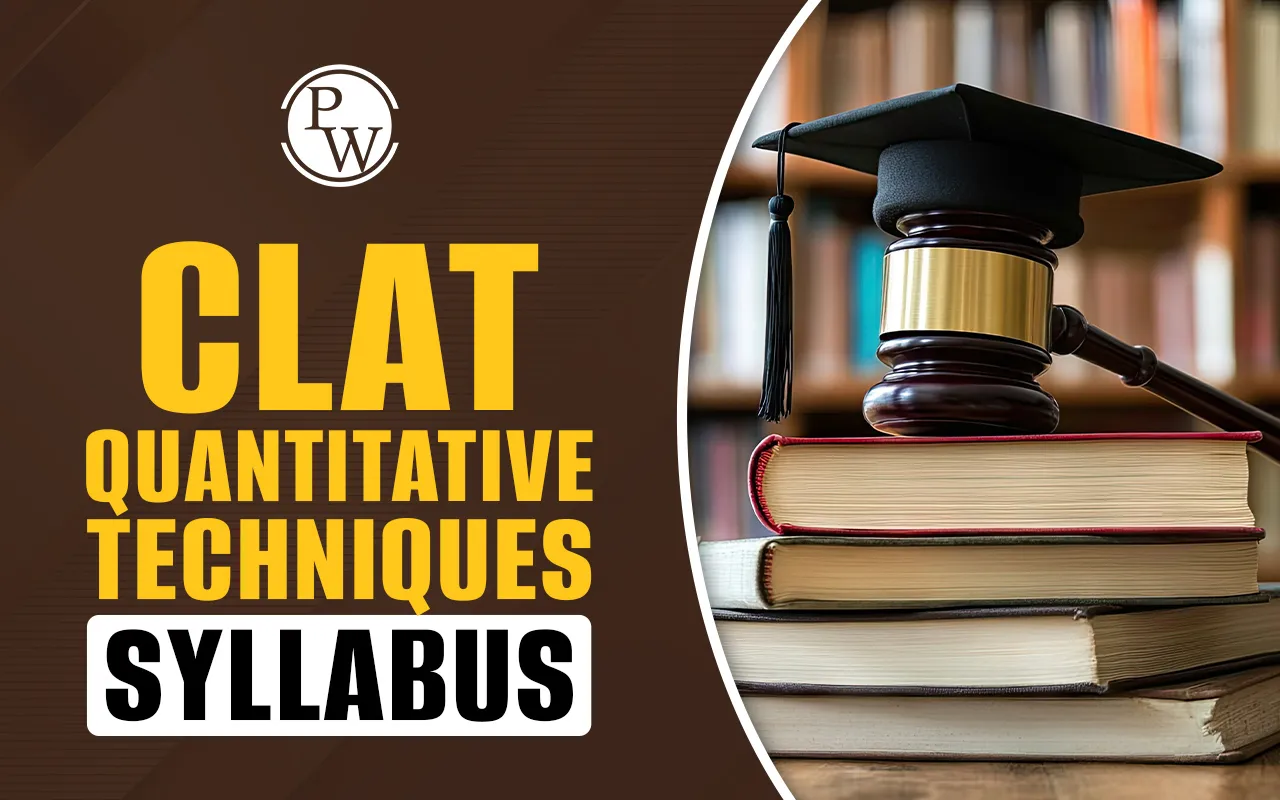

CLAT Quantitative Techniques Syllabus tests your basic mathematical ability and data interpretation skills. The CLAT syllabus includes topics like ratio and proportion, profit and loss, percentages, averages, and simple calculations. The CLAT questions are passage-based, where you must analyze numerical data and solve related multiple-choice questions.
Although this CLAT section has the least weightage in the paper, scoring well here can increase your overall rank. To prepare effectively, focus on accuracy, regular practice, and solving previous papers or CLAT mock tests to strengthen your speed and problem-solving confidence in the examination.
CLAT Quantitative Techniques Syllabus
The CLAT basically tests how well you can understand and work with numerical data given in passages. Check the CLAT Syllabus below and work on these topics to perform better in the CLAT exam:
|
CLAT Quantitative Techniques Syllabus |
|
|
Topics Covered |
Details of the Topics |
|
Basic Arithmetic |
Addition, Subtraction, Division, Multiplication, Number System, Decimals, Fraction and Functions Approximation, Roots, Surds and Indices, HCF and LCM, Average, Ratio and Proportion, Time and Work, Simplification, Logarithms, and Functions. |
|
Commercial Mathematics |
Percentage, Interest Calculation and Discounts, Partnership, Profit, Loss, etc. |
|
Modern Mathematics |
Clocks and Calender, Probability |
|
Mensuration |
Measurement, Volume, and Geometry. |
|
Algebra |
Basic Algebra and Its Applications |
Note - Practice all the important topics properly in detail. Do not leave any topic; practice it again and again. Ask for doubts if you have any from your teachers or friends, do not feel shy. Asking with doubts means having some questions still left.
CLAT Quantitative Techniques Exam Pattern
Even though the Quantitative Techniques section carries only about 10% weightage, it can be a deciding factor for candidates aiming for admission to top National Law Universities (NLUs). Strong performance here in the CLAT Exam can significantly increase your overall CLAT score. Check below for the CLAT Exam Pattern:
|
CLAT Quantitative Techniques Exam Pattern |
|
|
Particulars |
Details of the CLAT Exam Pattern |
|
Number of Questions in the CLAT Exam |
10-14 |
|
Negative Marking |
-0.25 (for each incorrect answer) |
|
Difficulty Level |
10th Class |
|
Types of Questions |
Short sets of facts or propositions, or other textual representations of numerical information, followed by a series of questions |
Tips to Attempt CLAT Quantitative Techniques Syllabus
Scoring well in the CLAT Quantitative Techniques section requires a mix of accuracy, speed, and smart strategy. Focus on strengthening basics, practicing data-based questions, and analyzing mock tests regularly. Check below for detailed CLAT exam tips to attempt this Quantitative section effectively:
1. Understand the CLAT Question Type
-
Study CLAT previous years’ papers to understand the pattern and style of questions. It is very important for any exam. From this, you can basically get an idea of the exams and practice similar questions further.
-
Expect short passages in the CLAT Quantitative section that contain numerical data, followed by questions that test your calculation and interpretation skills rather than direct formula-based solving.
2. Strengthen Basic Concepts for CLAT Exam
-
Revise foundational topics such as percentages, ratios and proportions, averages, profit and loss, and simple and compound interest.
-
Basically, develop comfort with tables, charts, and graphs, since questions often require quick and accurate data interpretation.
3. Practice Speed and Accuracy
-
Regularly solve CLAT Quantitative practice sets or timed quizzes to improve your speed under exam pressure. This will make a habit of yours to practice within in time limit.
-
Work on mental calculations and approximation techniques to reduce dependence on long calculations.
4. Focus on Data Interpretation Skills
-
Learn to extract only the necessary information from a passage and ignore irrelevant data.
-
Carefully read each question before attempting to avoid misinterpretation of the data provided.
5. Avoid Common Mistakes
-
Always read the question completely before starting calculations.
-
Double-check figures, units, and conversions to avoid minor but costly errors.
6. Use CLAT Quantitative Shortcuts Wisely
-
Practice quick-solving techniques and calculation tricks, but avoid overusing them if they lead to confusion.
-
Prioritize conceptual understanding over memorized shortcuts. Do not just learn everything focus on the concept behind it.
7. Practice Regularly with CLAT Mock Tests
-
Take regular CLAT mock tests and sectional tests to identify your strong and weak areas. Also, do not leave mistakes as it is, solve them again and gain. Ask doubts if there are any.
-
After CLAT every mock, check your mistakes carefully and practice similar question types again so that you can practice better and attempt better.
Mock Tests and Practice Sets for CLAT Quantitative Techniques
To strengthen their preparation for the CLAT Quantitative Techniques section, candidates can join our PW CLAT batches. These PW batches provide everything you need, from concept-wise video lectures and topic tests to full-length mock tests and practice sets based on the latest CLAT pattern.
Regular analysis sessions help identify weak areas and improve speed and accuracy. With proper guidance and materials made by our teachers, our batches ensure complete coverage of the syllabus and increase your overall CLAT performance.
